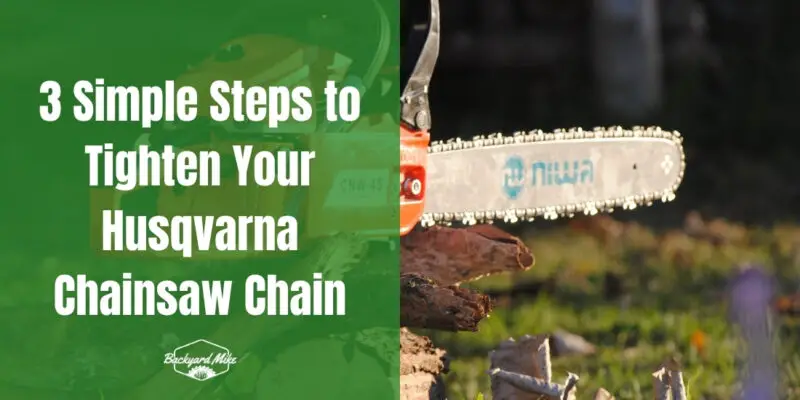First, prepare your chainsaw by gathering your safety gear and placing the saw on a flat surface, making sure the chain brake is engaged. Next, to adjust the chain tension, disengage the brake, then carefully turn the tensioning screw clockwise while holding the bar tip up, and make certain the chain moves smoothly. Finally, inspect the chain for correct seating, tighten the bar nuts securely, and verify everything is in place. For a deeper understanding, explore additional detailed instructions.
Key Takeaways
- Disengage the chain brake before adjusting the chain tension.
- Slightly loosen the bar nuts using a combination spanner.
- Turn the tensioning screw clockwise to tighten the chain.
- Ensure the chain moves smoothly without excessive tightness.
- Secure the bar nuts firmly after verifying proper chain tension.
Prepare Your Chainsaw for Adjustment
Before you begin adjusting your Husqvarna chainsaw chain, it's essential to prepare your workspace and equipment properly. Start with a clear workspace setup; remove clutter to prevent accidents. Gather your safety gear, including goggles and gloves, to protect yourself during the process. Make sure to refer to your chainsaw's manual for model-specific instructions. Have your tool set ready, including a screwdriver or wrench. A carburetor adjustment tool is also useful for tuning your chainsaw, ensuring optimal performance during use. Position your chainsaw securely on a flat surface to avoid movement. Safety precautions are vital. Engage the chain brake and confirm the engine is off and cool before starting. Check that the bar and chain are properly fitted, and that all coverings are in place. Familiarize yourself with the air purge system for starting and maintenance. Husqvarna chainsaws offer noise reduction features, making them among the quietest options available, which can be beneficial during maintenance and operation.
Adjust the Chain Tension
When adjusting the chain tension on your Husqvarna chainsaw, make sure the chain brake is disengaged to start safely. Begin by loosening the bar nuts slightly with a combination spanner to allow the chain to move. Locate the tensioning screw on the side of the guide bar; use your tension tools to turn it clockwise for tightening. Lift the tip of the bar to guarantee effective tensioning. Hold the top of the bar with one hand or brace it on a hard surface to maintain proper tension during adjustment. Check that the chain is slightly loose, but not slack, making certain it remains engaged at the bar nose. Pull it by hand—aim for smooth movement without excessive tightness. Proper chain maintenance reduces wear and safety risks, so check tension every time you refuel, especially during the running-in period of new chains. Investing in chainsaws with safety features is more cost-effective than potential hospital bills.
Secure and Verify the Chain
Begin by removing the bar nuts and clutch cover to access the chain area, making sure you've got your safety glasses and gloves on for protection. This is essential for chain maintenance and observing safety precautions.
Once everything's in place, visually inspect the chain to confirm it's seated correctly on the bar. It's important to check that the chain isn't slack underneath and can be rotated easily by hand. Guarantee the chain brake remains disengaged for your safety. Regular checks on chain tension are essential for optimal performance and prevent issues like overtightening. Proper chain tension can significantly enhance the cutting experience, ensuring efficiency and safety during operation.
- Tighten bar nuts finger-tight at first.
- Use a combination spanner for secure tightening.
- Avoid over-tightening to prevent damage.
- Confirm the clutch cover is fastened securely.
- Check for unusual chain vibrations after securing.
Double-check these steps to make certain your chainsaw is ready and safe for use.
Frequently Asked Questions
How Often Should I Replace My Chainsaw Chain?
You should replace your chainsaw chain when you notice reduced chain longevity, like dull teeth or cracks. Monitoring replacement frequency guarantees safety and performance, making you feel part of a knowledgeable community of responsible chainsaw users.
What Are Signs of a Worn-Out Guide Bar?
You should look for worn-out indicators like visible wear, burrs, or discoloration. Guide bar maintenance involves checking for cracks or concavity. Regularly inspect your guide bar to guarantee you're part of the community of safe, efficient users.
Can I Use Any Type of Chain Oil for Lubrication?
You're about to discover the truth about chain oil types. Not all oils are created equal. Consider oil viscosity and compatibility with your saw. Choosing the right one guarantees belonging in the community of experts who maintain peak performance.
How Can I Prevent Chain Stretching Over Time?
Prevent chain stretching by performing regular chain maintenance and tension adjustments. Always check chain tension and lubricate properly. Feel part of a community that values care and precision, ensuring your chainsaw lasts and works efficiently.
What Safety Gear Is Essential During Chainsaw Maintenance?
When maintaining your chainsaw, safety goggles protect your eyes, while cut-resistant gloves guard your hands. Stay safe and feel like part of the chainsaw community by wearing essential gear, ensuring safety and camaraderie while you work.
Conclusion
Now that you've tightened your Husqvarna chainsaw chain, you're ready to tackle your next cutting task efficiently. Remember, a properly adjusted chain guarantees safety and peak performance. For instance, imagine you're cutting firewood for winter; a loose chain could slow you down or cause accidents. By following these steps, you're making sure your chainsaw runs smoothly. Always double-check your adjustments, making certain the chain is secure before starting. Regular maintenance is key to prolonging your chainsaw's life.


